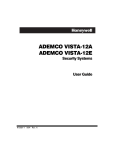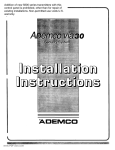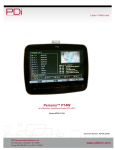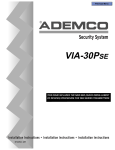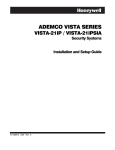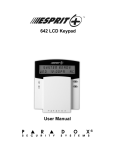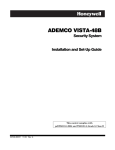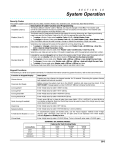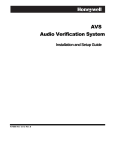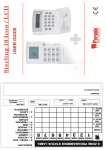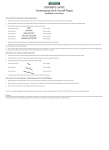Download System Operation
Transcript
System Operation • • • • • • • • • • • • • • • • • • • • • • • • • • • • • • • • • • • • • • • Security Codes The VISTA-20P system supports up to 48 security codes (VISTA-15P supports 32 codes), which can each be assigned one of 5 authority levels. The authority level determines the functions each code can perform as follows: Authority Levels (authority levels can be assigned to users 3-49 only; users 1 and 2 cannot be changed) Level Installer User No. 01 Functions perform all security functions except can disarm only if used to arm; can enter program mode (default=4112) System 02 only one system master code per system; can perform all security Master functions, add/delete users in either partition, change master code, view event log, set system clock, program keypad macro, program scheduled events, activate output devices (triggers/relays) Partition P1 = 03 VISTA-20P only. Same as Master, except add/delete users limited to Master P2 = 33 assigned partition only, (these users can be assigned different authority (default) levels, if desired; any user can be assigned the partition master authority level) 0-User 03-49 (V20P) perform security functions (arm, disarm, etc.) only; cannot add/delete 03-33 (V15P) users, view event log, set system clock or program scheduled events 1-Arm Only see “user” arm system only 2-Guest see “user” can disarm the system only if it was used to arm the system 3-Duress see “user” performs security functions, but also silently sends a duress message to the central station; reports as zone 92 4-Partition see “user” VISTA-20P only. See Partition Master paragraph above; used to assign Master other user numbers as partition masters Refer to the user guide for detailed procedures on adding/deleting security codes and changing user attributes. The following is a brief description of how to add user codes. Adding a User Code: Master code + [8] + 2-digit user no. + user’s code Deleting a User Code: Master code + [8] + 2-digit user no. + [#] [0] Assigning Attributes: Master code + [8] + 2-digit user no. + [#] [attribute no.] + value Attributes: Values 1 = Authority Level 0-4 (see Authority Level table above) 2 = Access Group 0-8 (0 = not assigned to a group) 3 = Active Partition(s) 1, 2, 3 (common) for this user; Enter partitions consecutively if more than one and press [#] to end the entries. 4 = RF Zone No. Assigns user number to button type zone for arm/disarm. 5 = Open/Close Paging 1 for yes, 0 for no Keypad Functions The following is a brief list of system commands. For detailed information concerning system functions, refer to the User's Manual. Function Description Silence alarms Pressing any key will silence the keypad sounder for 10 seconds. Disarming the system will silence both keypad and external sounders. Quick Arm If enabled (field Q21), you can press [#] in place of the system's security code, plus the desired arming key (Away, Stay, Instant, Maximum) Single-Button arming If programmed (*57 Function Key menu mode), lettered keys A-D can be used for arming, using options 3-AWAY, 4-STAY, 5-NIGHT-STAY, or 6-Step-Arming If used, no security code is required to arm the system. Alarm Memory When the system is disarmed, any zones that were in an alarm condition during the armed period will be displayed. To clear this display, simply repeat the disarm sequence (enter the security code and press the OFF key) again. Arming Away Enter code + AWAY [2] or simply press appropriate lettered key on the keypads (see “Single-Button Arming” above). Arming Stay Enter code + STAY [3] or simply press appropriate key on the keypads (see “SingleButton Arming” above). Arming Night-Stay Enter code + STAY [3] + STAY [3] or simply press appropriate key on the keypads (see “Single-Button Arming” above). Arming Instant Enter code + INSTANT [7]. Arming Maximum Enter code + MAXIMUM [4] or simply press appropriate lettered key on the keypads (see “Single-Button Arming” above). Disarming Enter code + OFF [1]. Bypassing Zones Enter code + BYPASS [6] + zone number(s). Forced (Quick) Bypass To automatically bypass all faulted zones, use the “Quick Bypass” method. Enter code + BYPASS + [#], then wait for all open zones to be displayed. Arm when display indicates “ZONE BYPASSED” and “READY TO ARM”. Chime Mode Enter code + CHIME [9]. To turn chime off, enter code + CHIME again. Activate Output Devices If relay outputs (via a 4204, or 4229), or Powerline Carrier devices are used, two keypad entries available to the user are included. If programmed, these entries can be used to manually activate or deactivate the device(s) for starting or stopping some action, such as turning lights on or off, etc. These keypad entries are: [Security Code] + # + 7 + [2-digit Device #] activates (starts) that device. [Security Code] + # + 8 + [2-digit Device #] deactivates (stops) that device. SUMMARY OF ARMING MODES Arming Mode Features for Each Arming Mode Exit Delay Entry Delay Perimeter Armed Interior Armed AWAY STAY NIGHT-STAY Yes Yes Yes Yes Yes Yes Yes Yes Yes Yes No INSTANT MAXIMUM Yes Yes No No Yes Yes only those zones listed in NightStay zone list No Yes Panic Keys There are three Panic keys (A, B, and C) that, if programmed, can be used to manually initiate alarms and send a report to the central station. Each key can be programmed for 24-hour Silent, 24-hour Audible, Fire, or Personal Emergency responses. The programmed Panic response is activated when the appropriate key is pressed for at least 2 seconds. The Panic keys are identified by the system as follows: Keys Displayed as Zone [A] (∗/1) 95 [B] (∗/#) 99 [C] (3/#) 96 IMPORTANT: For a Silent panic function (if programmed) to be of practical value, you must program a report code for the zone and the system must be connected to a central station. Various System Trouble Displays Alpha Display Fixed Disp. Meaning CANCELED ALARM CA will appear if an exit or interior zone contained a fault during closing at the time the Exit Delay ended (e.g., exit door left open), but the system was disarmed during the Entry Delay time. The alarm sounder and keypad sound continuously, but stop when the system is disarmed. No message will be transmitted to the central station. EXIT ALARM EA will appear when the Exit Delay ends if an exit or interior zone contained a fault during closing. The alarm sounder and keypad sound continuously until the system is disarmed (or timeout occurs). An “Exit Alarm” message is sent to the central station. Also results if an alarm from an exit or interior zone occurs within 2 minutes after the end of an Exit Delay. CHECK CHECK indicates that a problem exists with the displayed zone(s) and requires attention. Note: The control will sense a high resistance in the loops on hardwired zones 2–8 and display “CHECK” and the affected zone number when the system is in the disarmed mode. It will not be possible to arm the system as long as this condition exists (unless this zone is bypassed). If the system is in the armed mode when the high resistance condition occurs, this display will not appear, but will do so as soon as the system is disarmed. Check the sensor or the loop wiring for the displayed zone. ALARM 1xx FAULT 1xx CHECK 1xx 1xx 1xx 1xx indicates that communication between control and a zone expander or wireless receiver is interrupted, where “xx” is the device address. Check the wiring and DIP switch settings on the units. If field *199 is set to “1,” all ECP module problems are displayed as “91.” If there are wireless sensors in the system, the Check condition may also be caused by some change in the environment that prevents the receiver from receiving signals from a particular sensor. 91 SYSTEM LO BAT LO BAT BAT BAT with no zone number indicates that the system's main standby battery is weak. TELCO FAULT 94 Telephone Line Failure, indicates that a monitored telephone line (if programmed in field *92) has been cut or disconnected. Depending on how the system was programmed, the keypad may also produce a trouble sound, and the external sounder may be activated. Silence by entering installer code + OFF. Busy-Standby dl If this remains displayed for more than 1 minute, the system is disabled. with a zone number and a once-per-minute beeping at the keypad indicates that a low-battery condition exists in the wireless sensor displayed (zone “00” indicates a wireless keypad). If the battery is not replaced within 30 days, a “CHECK” display may occur. Note: Some wireless sensors contain a non-replaceable long-life battery which requires replacement of the entire unit at the end of battery life (e.g., Nos. 5802, 5802CP). Alpha Display Modem Comm Fixed Disp. Meaning The system is in communication with the central station for change of function or CC status verification. no display no display Power Failure If there is no keypad display at all and the LEDs are unlit, operating power (AC and battery) for the system has stopped and the system is inoperative. If the message “AC LOSS” (Alpha display keypads) or “NO AC” (Fixed-Word display keypads) is displayed, the keypad is operating on battery power only. If the battery standby capacity is used up during a prolonged AC power outage, the control's power will shut down to minimize deep discharge of the battery. Comm. Failure Open Circuit Long Rng Trbl Bell Failure RCVR Jam KEYPAD LOW BAT Phone Okay Dialer Off Test in Progress Upload Completed Upload Failed FC OC bF A communication failure has occurred. 70 Bell supervision failure. 90 RF jam detected. 00 BAT Cd dO dd dC dF Wireless keypad low battery The keypad is not receiving signals from the control and sees an open circuit. Backup LRR communication failure. The dialer test has been successful (CID code 601). The dialer is disabled. Walk test mode is active(CID code 607). The upload or download session was completed. The upload or download session failed before completion.





